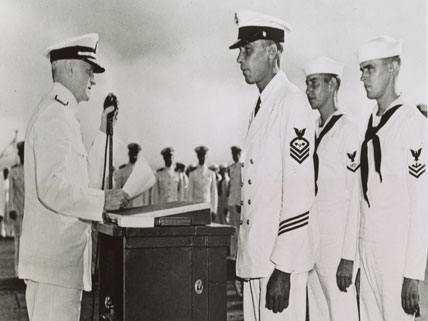 Fleet Admiral Chester Nimitz (left) presents awards to three U.S. Navy fliers, 1942.
Fleet Admiral Chester Nimitz (left) presents awards to three U.S. Navy fliers, 1942.
The Naval War College Library unveiled to the public last month what naval historian Douglas Smith calls “the most authoritative source on the Pacific War available anywhere.” Known as the Gray Book, the collection—available now for the first time online—consists of the diary and dispatches of Fleet Admiral Chester W. Nimitz, architect of the Allied victory over the Japanese. The eight volumes include Nimitz’s communications from the day Pearl Harbor was attacked to the days preceding Japan’s formal surrender aboard the USS Missouri. Daily situation estimates, a running record of command decisions, and summaries of communications provide a “fly-on-the-wall” look at U.S. strategic decision making during World War II’s pivotal naval battles.
Announcement of the online release coincided with the anniversary of Admiral Nimitz’s birthday, February 24. Chester William Nimitz was born in Fredericksburg, Texas, in 1885, the grandson of a retired sea captain. The young Nimitz left for the United States Naval Academy at Annapolis in 1901. He advanced through the ranks to become a rear admiral in 1938. Immediately following the Japanese attack on Pearl Harbor, he was appointed Commander in Chief, Pacific Fleet and Pacific Ocean Areas, and became the first U.S. naval officer to be promoted to the rank of fleet admiral (five stars). Together with U.S. Army General Douglas MacArthur, who commanded the Southwest Pacific theater, Nimitz led Allied forces during the Pacific War from the outset until September 2, 1945. On that historic V-J Day, Admiral Nimitz was the United States signatory to the surrender of Imperial Japan aboard the battleship USS Missouri in Tokyo Bay.
The Gray Book, which runs to more than 4,000 pages, was declassified in 1972. The original documents, which fill 28 bankers boxes, are housed at the Washington Navy Yard in Washington, D.C. For many years, scholars interested in examining this primary source had no choice but to travel to the archives there. Thanks to improvements in digital scanning technology, the collection is now available to researchers and naval history buffs everywhere.
Image credit: © Library of Congress, Prints and Photographs Collection
Related Links
- Legendary Admiral’s WWII Diary to Be Released Online
This article discusses the importance of Fleet Admiral Chester W. Nimitz to the Allied victory in World War II, and the significance evidenced of the Gray Book primary source collection.
(Source: History.com, February 21, 2014) - Nimitz Diary Unveils Naval War College Legacy of Learning
This article on the ceremony unveiling the online Nimitz Gray Book includes a summary of the lecture on the Battle of Midway.
(Source: Ho’okele–Pearl Harbor–Hickam News, | March 7, 2014) - Naval Historical Collection: The Nimitz Graybook
Access here the eight volumes of the Nimitz Gray Book.
(Source: United States Navy War College; accessed March 14, 2014) - Biographies in Naval History: Fleet Admiral Chester William Nimitz
This brief biography of World War II’s most successful admiral covers the highlights of his naval career.
(Source: Navy.mil; accessed March 14, 2014)




I have to write about this article
and I would really appreciate if you could leave the authors name.
Thank you